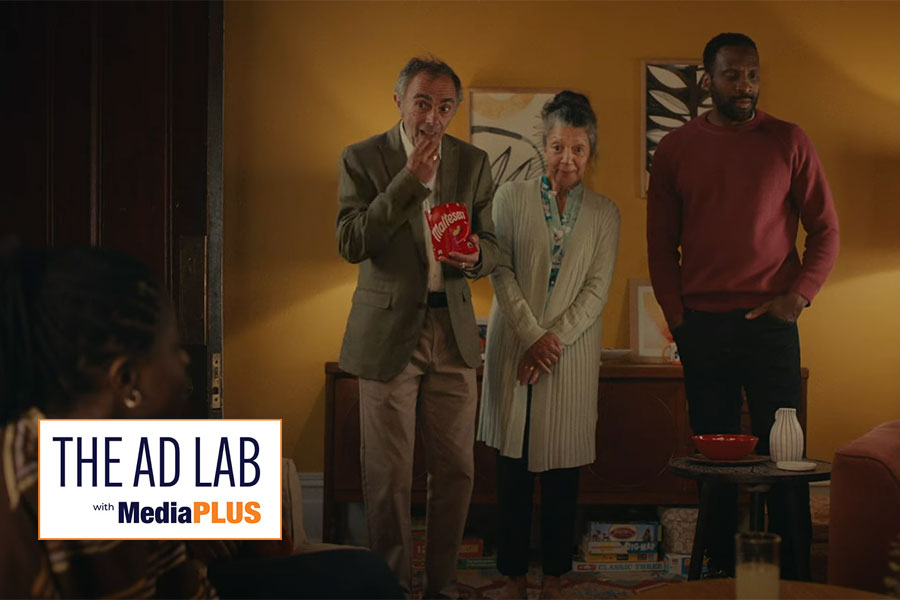Every week, Amárach and Future Proof Insights share exclusive findings from their PRIZM+ ad testing service, showcasing best practice creative advertising in Ireland.
Maltesers plays it light with a scene-stealing grandmother and a companion whose presence is more unsettling than smooth.
The opening draws viewers into a classic family moment before flipping expectations with a risqué joke.
But while it delivers a knowing smirk, the brain data suggests the storytelling doesn’t quite hit the sweet spot when it comes to influencing behaviour.
From the outset, curiosity rises as the grandmother and Gerard enter.
This moment activates the Von Restorff Effect (also known as the isolation effect): unusual or distinctive stimuli are more likely to be remembered.
Viewers are trying to make sense of this atypical pairing; we've come to expect younger couples introducing their partners to the family, but this flips that dynamic on its head.
This successfully creates the tension and active engagement, providing a platform for the scenes to come.
As the ad moves into wider shots, the sense of intimacy fades and so does the audience's mental grip.
What began with curiosity drifts into passivity.
In these moments, the lack of stimulation becomes critical.
We see engagement slip, and with it, the opportunity to solidify meaning.
While neural impact remains generally steady, we don't see sharp peaks, those spikes that signal emotionally powerful scenes being written into long-term memory.
In a 20-second spot, losing just a few seconds of effective cognitive processing is costly.
When cognitive load drops too low, viewers get comfortable but not committed.
Without effortful processing, there's little reason for the brain to hang onto the content.
It’s a textbook case of underpowered encoding; viewers watch, but they don’t walk away with anything that shifts behaviour in the long run.
However, when the grandmother lands her punchline, we see a clear emotional spike.
That moment is a prime example of the peak-end rule: people remember emotionally intense moments and how an experience ends more than the middle.
But here, the peak arrives without strong brand reinforcement.
The emotional payload isn’t tied to a behavioural goal like purchase or sharing. The crunch of the Malteser at the end helps, but it feels tacked on, a cue rather than a driver.
Across the ad, we see signs of the humour overhang effect, where the joke is remembered but stripped of its brand origin.
From an advertising lens, humour is a double-edged sword: it captures attention and entertains, but unless tightly coupled with the brand, it can reduce recall or shift attribution elsewhere.
Despite these drawbacks, the ad scores strongly on memorisation.
The scene with Gerard’s deadpan delivery is a “sticky” moment, boosted by emotional salience and its unexpected nature.
But these aren’t connected to a persuasive claim. This creates the potential for misattribution effects, where viewers remember the feeling and the scene, but not who it was for.
From a behavioural perspective, the COM-B data shows the ad builds some awareness but struggles to drive stronger downstream behaviours like intent or action.
Automatic motivation—such as emotional response and positive affect—shows moderate uplift, suggesting the tone and humour land reasonably well.
However, reflective motivation remains low. Viewers don’t get a clear sense of why Maltesers, why now, or what the role of the product is in the story beyond being a prop.
Capability is limited—there is no functional message or clear action to take.
Opportunity scores are muted too, with little contextual prompting to suggest when or where the product should be consumed.
When we drill into demographic splits, we see above-average response among younger viewers (18-34), particularly females.
The irreverence and tone resonate, and emotional engagement is higher here than for older cohorts. But this uplift doesn’t carry through into behavioural indicators.
Among older viewers, the behavioural impact is notably weaker, suggesting that while the concept entertains, it may not translate into brand-relevant behaviours without clearer framing.
The grandmother’s bold honesty activates contrast framing by disrupting expectations of how older characters behave, making her more memorable.
But these micro-moments need scaffolding, a structure that links emotion, brand, and behaviour.
To elevate this ad from memorable to motivating, Maltesers needs to reframe its peak moments through the lens of brand or product benefit.
Stronger use of associative encoding could fuse emotional response with product relevance.
That means more than showing the bag. It means letting the brand become part of the joke, part of the resolution, part of the action.
The ad has charm. But charm alone doesn't change behaviour.
To shift the dial on purchase intent and drive action, the brand needs to appear not just at the end, but in the moments when the brain decides what matters.
For more insights from PRIZM+ on how neuroscience drives advertising impact, visit: https://www.futureproofinsights.ie/prizm-plus/









